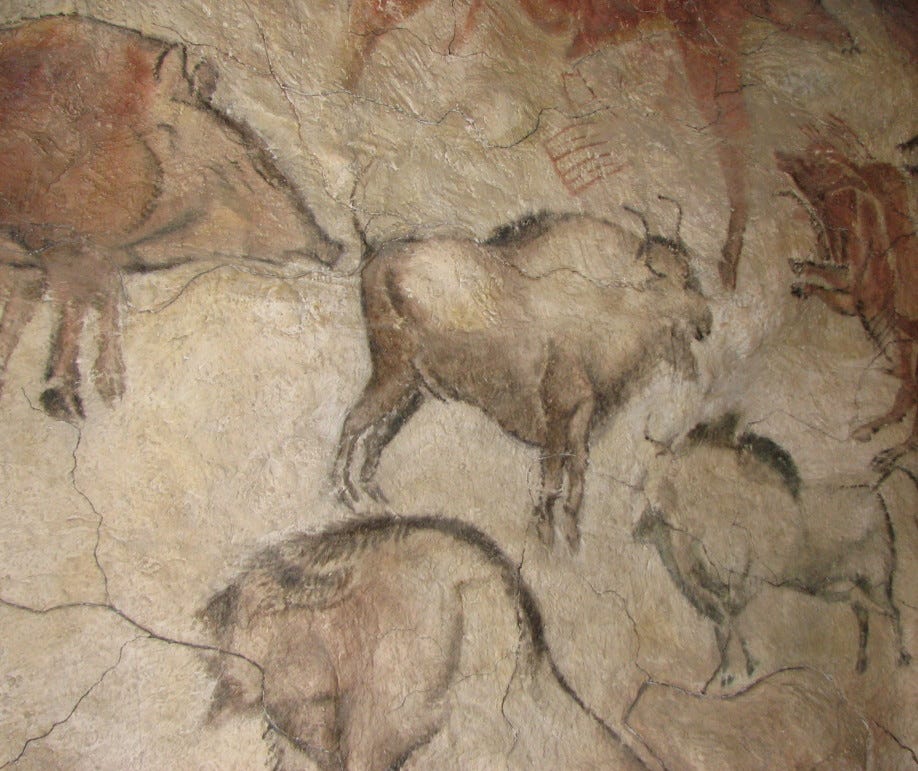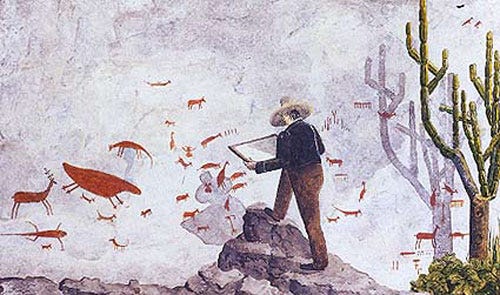[A priest and a boy explored a cave…]
This secret chamber of rock, when illuminated after its long night of unnumbered ages, revealed on its walls large and sprawling outlines diversified with coloured earths; and when they followed the lines of them they recognised, across that vast and void of ages, the movement and the gesture of a man’s hand. They were drawings or paintings of animals; and they were drawn or painted not only by a man but by an artist. Under whatever archaic limitations, they showed that love of the long sweeping or the long wavering line which any man who has ever drawn or tried to draw will recognise; and about which no artist will allow himself to be contradicted by any scientist. They showed the experimental and adventurous spirit of the artist, the spirit that does not avoid but attempt difficult things; as where the draughtsman had represented the action of the stag when he swings his head clean round and noses towards his tail, an action familiar enough in the horse. But there are many modern animal-painters who would set themselves something of a task in rendering it truly. In this and twenty other details it is clear that the artist had watched animals with a certain interest and presumably a certain pleasure. In that sense it would seem that he was not only an artist but a naturalist; the sort of naturalist who is really natural.
Now it is needless to note, except in passing, that there is nothing whatever in the atmosphere of that cave to suggest the bleak and pessimistic atmosphere of that journalistic cave of the winds, that blows and bellows about us with countless echoes concerning the cave-man. So far as any human character can be hinted at by such traces of the past, that human character is quite human and even humane. It is certainly not the ideal of an inhuman character, like the abstraction invoked in popular science. When novelists and educationists and psychologists of all sorts talk about the cave-man, they never conceive him in connection with anything that is really in the cave. When the realist of the sex novel writes, ‘Red sparks danced in Dagmar Doubledick’s brain; he felt the spirit of the cave-man rising within him,’ the novelist’s readers would be very much disappointed if Dagmar only went off and drew large pictures of cows on the drawing-room wall. When the psychoanalyst writes to a patient, ‘The submerged instincts of the cave-man are doubtless prompting you to gratify a violent impulse,’ he does not refer to the impulse to paint in water-colours; or to make conscientious studies of how cattle swing their heads when they graze. Yet we do know for a fact that the cave-man did these mild and innocent things; and we have not the most minute speck of evidence that he did any of the violent and ferocious things. In other words, the cave-man as commonly presented to us is simply a myth or rather a muddle; for a myth has at least an imaginative outline of truth. The whole of the current way of talking is simply a confusion and a misunderstanding, founded on no sort of scientific evidence and valued only as an excuse for a very modern mood of anarchy. If any gentleman wants to knock a woman about, he can surely be a cad without taking away the character of the cave-man, about whom we know next to nothing except what we can gather from a few harmless and pleasing pictures on a wall.
But this is not the point about the pictures or the particular moral here to be drawn from them. That moral is something much larger and simpler, so large and simple that when it is first stated it will sound childish. And indeed it is in the highest sense childish; and that is why I have in this apologue in some sense seen it through the eyes of a child. It is the biggest of all the facts really facing the boy in the cavern; and is perhaps too big to be seen. If the boy was one of the flock of the priest, it may be presumed that he had been trained in a certain quality of common sense; that common sense that often comes to us in the form of tradition. In that case he would simply recognise the primitive man’s work as the work of a man, interesting but in no way incredible in being primitive. He would see what was there to see; and he would not be tempted into seeing what was not there, by any evolutionary excitement or fashionable speculation. If he had heard of such things he would admit, of course, that the speculations might be true and were not incompatible with the facts that were true. The artist may have had another side to his character besides that which he has alone left on record in his works of art. The primitive man may have taken a pleasure in beating women as well as in drawing animals; all we can say is that the drawings record the one but not the other. It may be true that when the cave-man’s finished jumping on his mother, or his wife as the case may be, he loves to hear the little brook a-gurgling, and also to watch the deer as they come down to drink at the brook. These things are not impossible, but they are irrelevant. The common sense of the child could confine itself to learning from the facts what the facts have to teach; and the pictures in the cave are very nearly all the facts there are. So far as that evidence goes, the child would be justified in assuming that a man had represented animals with rock and red ochre for the same reason as he himself was in the habit of trying to represent animals with charcoal and red chalk. The man had drawn a stag just as the child had drawn a horse; because it was fun. The man had drawn a stag with his head turned as the child had drawn a pig with his eyes shut; because it was difficult. The child and the man, being both human, would be united by the brotherhood of men; and the brotherhood of men is even nobler when it bridges the abyss of ages than when it bridges only the chasm of class. But anyhow he would see no evidence of the cave-man of crude evolutionism; because there is none to be seen. If somebody told him that the pictures had all been drawn by St. Francis of Assisi out of pure and saintly love of animals, there would be nothing in the cave to contradict it.
Thank you for reading Von’s Substack. I would love it if you commented! I love hearing from readers, especially critical comments. I would love to start more letter exchanges, so if there’s a subject you’re interested in, get writing and tag me!
Being ‘restacked’ and mentioned in ‘notes’ is very important for lesser-known stacks so… feel free! I’m semi-retired and write as a ministry (and for fun) so you don’t need to feel guilty you aren’t paying for anything, but if you enjoy my writing (even if you dramatically disagree with it), then restack, please! Or mention me in one of your own posts.
If I don’t write you back it is almost certain that I didn’t see it, so please feel free to comment and link to your post. Or if you just think I would be interested in your post!
Thanks again, God Bless, Soli Deo gloria,
Von
Links
Quotes
A bunch of fun and significant quotes:
John Taylor Gatto #1
John Taylor Gatto #2
John Taylor Gatto #3
Education Quotes #2
Education Quotes #1
Chesterton
A Folly of Socialism
The Fire and the Wife
Ignorance Covered with Impudence
Is there only One Party?
The Feminine Ideal
The Long Word // Podcast Version
The Caveman and the Club // Podcast Version
Poems
Posting and analysing some important poems.







Reading Everlasting Man again at the moment. Always good stuff.